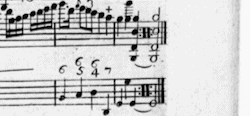Term coined by Robert O. Gjerdingen.
In the words of Gjerdingen, referring to the first movement of Keyboard Sonata in C major KV545 by Mozart: “The endings of the first and second halves of a famous Mozart keyboard sonata present the two most common variants of the Final Fall… The first is the more galant, and involves a fall from ➌ to ➊ (in the local tonic, here G major). The second, which closes the second half of this movement, falls an octave from ➊ to ➊ in C major. Nineteenth-century musicians appear to have favored the octave version of the Final Fall, and it can be heard at the end of many Romantic concert works for piano” (Gjerdingen (2007), p. 168).


Notice how the bass contributes to the different impact of the ➌-to-➊ and the ➊-to-➊ Final Fall. During the ➌-to-➊ Final Fall, the bass simply repeats the same pitch(es), while it also leaps down an octave —in fact, even two— during the ➊-to-➊ Final Fall.
Select Bibliography
Gjerdingen, Robert O. Music in the Galant Style (New York: Oxford University Press, 2007).
